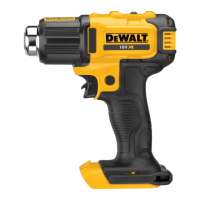11
ENGLISH
Cleaning
WARNING: Blow dirt and dust out of the main housing
with dry air as often as dirt is seen collecting in and around
the air vents. Wear approved eye protection and approved
dust mask when performing thisprocedure.
WARNING: Never use solvents or other harsh chemicals
for cleaning the non-metallic parts of the tool. These
chemicals may weaken the materials used in these parts.
Use a cloth dampened only with water and mild soap.
Lubrication
Your power tool requires no additionallubrication.
MAINTENANCE
Your power tool has been designed to operate over a long
period of time with a minimum of maintenance. Continuous
satisfactory operation depends upon proper tool care and
regularcleaning.
WARNING: To reduce the risk of serious personal
injury, turn tool off and disconnect battery pack
before making any adjustments or removing/
installing attachments or accessories. An accidental
start-up can causeinjury.
The charger and battery pack are notserviceable.
Prior to Operation (Fig. A)
WARNING: Make sure the nozzle always points away
from you and anybystanders.
WARNING: DO NOT drop anything into thenozzle.
WARNING: DO NOT exceed 60 minutes "ON" in a
2hourperiod.
1. Attach the correct accessory recommended for
theapplication.
2. Slide the air temperature adjustment switch
3
to desired
airtemperature.
NOTE: During operation pauses, ensure that the heat gun is
placed in such a way that it will not tip over. Place the heat gun
in a location where it will not be inadvertently knocked over
and is free of flammable materials. If the product is bumped
or placed poorly it could fall and burn or ignite materials in
thearea.
Switching On and Off (Fig.A, D)
1. Push the air temperature adjustment switch
3
to the
desired air flow settings:
2. Allow air flow to heat up the workpieceslowly.
I 109 l/min (290 ˚C)
A high air flow to heat up the workpiecequickly.
II 190 l/min (530 ˚C)
3. To power on: flip trigger switch
1
upwards and pull
trigger
10
in. To keep the unit on hands free then, press in
the lock-on button
8
on the left with your thumb.
4. To turn the unit off release the trigger. If the trigger is
locked -on, squeeze the trigger slightly to disengage the
lock-off button and then release the trigger.
NOTE: Disconnect the tool from the power source and let the
tool cool down before moving or storingit.
NOTE: When using hands free operation ensure that the
heat gun is placed in such a way that it will not tip over. Place
the heat gun in a location where it will not be inadvertently
knocked over and is free of flammable materials. If the product
is bumped or placed poorly it could fall and burn or ignite
materials in thearea.
Removing Paint (Fig. A)
WARNING: Refer to Important Notice under
Important Safety Instructions before using the tool to
removepaint.
WARNING: Do not strip metal window frames as the heat
may crack theglass.
• When striping other window frames, use a glass
protectionnozzle.
• To prevent igniting the surface, do not keep the tool
directed at one spot toolong.
• Avoid collecting paint on the scraper accessory, as it
may ignite. If necessary, carefully remove paint debris
from the scraper accessory using aknife.
1. Attach the appropriateaccessory.
2. Slide the air temperature adjustment switch
3
tohigh.
3. Turn the tool on by flipping trigger switch
1
upwards and
pulling trigger
10
in.
4. Direct the hot air onto the paint to beremoved.
Best results will be achieved if the heat gun is moved slowly,
but CONSTANTLY, from side to side to evenly distribute
heat. DO NOT LINGER OR PAUSE IN ONESPOT.
5. When the paint softens, scrape the paint away using a
handscraper.
REMEMBER: Splinters and small particles of stripped paint can
be ignited and blown through holes and cracks in the surface
beingstripped.
Stationary Use (Fig. E)
This tool can also be used in stationarymode.
1. Set the tool onto a level, stable workbench. Ensure the tool
will not tipover.
2. Turn the tool on by selecting the desired airflow.
Cool Down Period (Fig. F)
The nozzle and accessory becomes very hot during use. Turn
heat gun off, disconnect from the power source and set the tool
onto a level, stable workbench. Ensure the tool will not tip over.
Let the tool cool down for at least 30 minutes before moving or
storingit.
NOTE: To reduce the cooling time, switch the tool on at the
lowest air temperature setting and let it run for a few minutes
before turning the heat gunoff.

